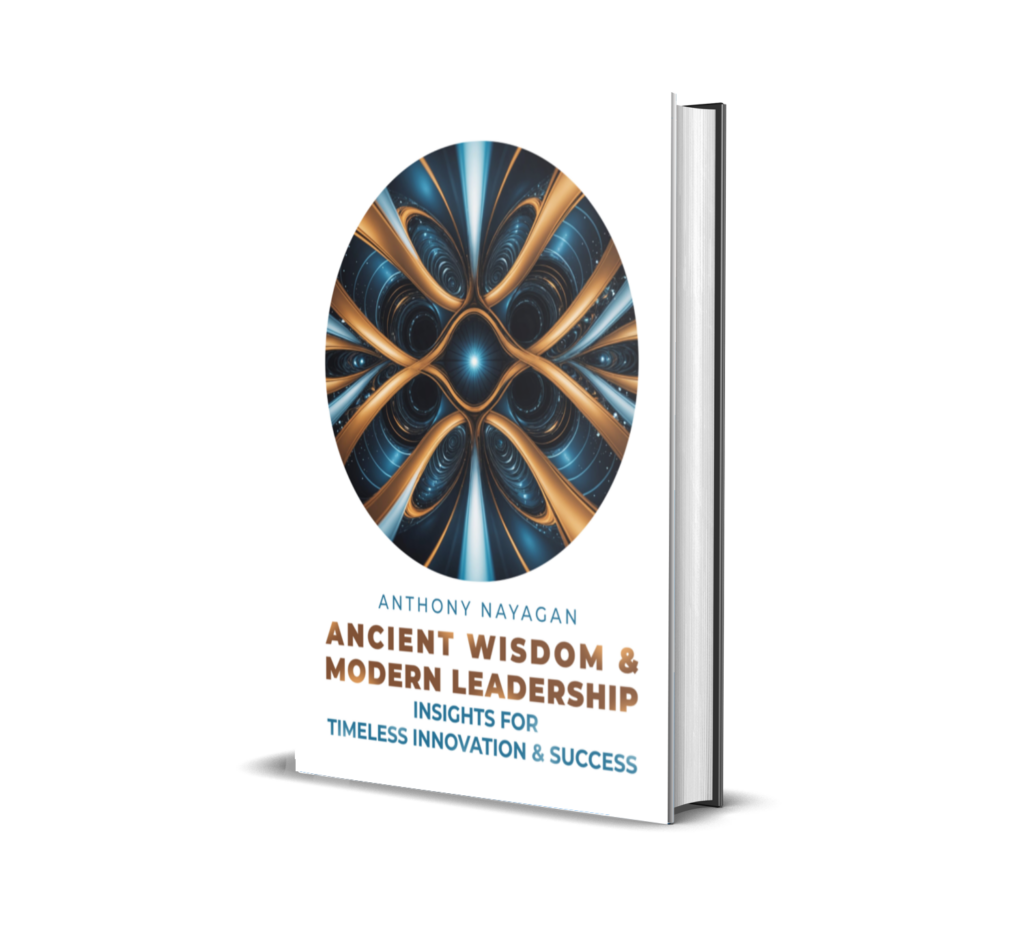Bridging Ancient Wisdom, Modern Science, and the Divine for Spiritual Leadership and Innovation
This article aims to inspire thought-leaders and creatives to embrace lives filled with spiritual wisdom. Anthony Nayagan, as a spiritual coach/mentor, guides innovators to unlock their divine potential, moving beyond the ordinary into a realm of profound wisdom. This journey not only enhances their professional and creative aspirations but also deepens their spiritual growth. By transcending conventional boundaries, they tap into extraordinary inner resources, discovering a new sense of purpose and growth that surpasses expectations and leads to transformative personal fulfillment.
The concept of creation has fascinated humanity for millennia. Ancient civilizations sought to explain the origins of existence, the forces that shape reality, and our place within the cosmos. The Vedas, the foundational scriptures of ancient Indian wisdom, offer profound insights into this mystery. According to the Vedas, creation is a dynamic process in which the Unmanifest — the boundless, formless essence — evolves into the manifested reality we perceive. This view isn’t merely a poetic or metaphysical explanation but aligns with the principles of modern quantum physics, where fields of potential give rise to matter.
The idea that the Unmanifest gives birth to the tangible resonates with modern science. In physics, quantum fields are understood to underlie all matter, much like the Vedas’ description of creation. The essence of creation, according to the Vedas, is not a random, chaotic process, but an evolution from the subtle, imperceptible reality into the material world we interact with. Similarly, quantum fields evolve, eventually giving rise to atoms and molecules — the very building blocks of the universe. This evolving journey from the unmanifest to the manifest reality parallels both ancient spiritual teachings and the cutting edge of physics.
Yet, science, particularly quantum physics, has shown us that matter and energy are not as straightforward as classical physics once suggested. Despite this, many educational systems still adhere to outdated models of classical physics, which focus on a predictable, reductionist understanding of the universe. This raises an important question for spirituality: If the universe is not simply a machine-like, reducible system but rather an interconnected field of potentials and energies, how should we understand our place in it?
For centuries, classical physics — Newton’s laws, for instance — taught that the universe operates like a well-oiled machine, governed by strict cause and effect. This perspective encouraged the idea that everything could be understood by breaking it down into its smallest components, a method known as reductionism. However, as quantum physics emerged, it became clear that the universe operates on principles that transcend simple cause-and-effect logic. At the subatomic level, particles behave in ways that defy our understanding of space, time, and matter. They exist in multiple states simultaneously, influencing one another in ways we still don’t fully comprehend. These discoveries have fundamentally challenged the reductionist view of reality.
But here’s the crucial point: Most of our intellectual and educational institutions continue to cling to these old paradigms. This is not just an academic oversight; it speaks to a broader spiritual disconnect. In holding onto classical physics’ outdated ideas, we inadvertently limit our understanding of deeper spiritual truths. We focus on the material, the tangible, the scientifically measurable, while ignoring the subtle, the energetic, and the unmanifest — the very aspects of reality that quantum physics is bringing into focus. This reluctance to evolve our thinking is also reflected in how we approach spirituality and our understanding of the divine.
While science and spirituality have often been seen as separate or even opposing forces, they are, in truth, two sides of the same coin. As Albert Einstein once said, “Science without religion is lame, religion without science is blind.” Science does not create anything new; it merely observes and explains what already exists. And when viewed from a metaphysical lens, science can reveal the nature of God. The unmanifest nature of God, much like the unmanifest quantum fields that birth matter, can only be understood through human realization. Modern physics, in its pursuit of understanding the fundamental nature of reality, brings us closer to understanding the divine.
All religions, whether Christianity, Hinduism, Buddhism, or others, seek to understand God in their own way. They use symbolism, doctrines, and teachings to interpret and explain the divine presence in the world. The concept of immanence, which holds that the divine is present and active in the material world, is central to many religious traditions. However, the unmanifest nature of God — the aspect of God that exists beyond form and definition — cannot be easily captured by these doctrines and teachings.
This perhaps explains why institutional religions are seeing a significant decline. People are leaving organized religions in the millions, while atheism and agnosticism are on the rise. Could it be that the rigid doctrines and intellectual definitions of God no longer resonate with our deeper understanding of reality? The unmanifest nature of God, by definition, defies structure, doctrine, and physical manifestation. It is the essence of pure potential, beyond the reach of human intellect and definition. So, when we attempt to confine God to a set of rules, images, and teachings, we inevitably fall short of capturing the full mystery of the divine.
Consider this: When we say we are created in the image of God, we do not mean that our physical bodies resemble the divine. Instead, we mean that the unmanifest aspects within us — our consciousness, our spirit — are reflections of the divine nature. Our material bodies are but temporary vessels for the soul. It is the elements of ourselves that are unmanifest — our inner life force, our consciousness, our spirit — that are truly made in God’s image. This realization calls us to look beyond the physical world and explore the unmanifest dimensions of our existence.
The growing discontent with institutional religions may be a reflection of a deeper spiritual hunger. People are searching for a connection with the divine that transcends dogma, ritual, and external forms. They are yearning to understand the unmanifest within themselves and in the universe around them. This is where spirituality diverges from religion: spirituality invites us to embrace the mystery, to explore the unmanifest aspects of our being, rather than relying on rigid doctrines to explain the divine.
In this search for the unmanifest, we must acknowledge the aspects of ourselves that remain hidden, dormant, or misunderstood. Our life force, our soul, our spirit — these are faculties of our existence that often remain unexamined until we face a crisis. Why is this? Our minds are wired to focus on the material world. We look for sensory experiences that connect us to our physical existence. But in doing so, we overlook the unmanifest dimensions of our being. It is ironic that the very instrument we use to interpret the world — the mind — is itself an unmanifest faculty.
Our knowledge, too, is unmanifest. We have built our entire educational and intellectual systems around a materialistic, reductionist understanding of the world. We have engineered our knowledge to fit within a framework that is matter-centric and reductionistic. But to fully understand the mind and its original unmanifest capacity, we have much to unlearn. This process of unlearning is known as transcendence.
Transcendence allows us to go beyond the limitations of the physical world and observe our life force, our soul, in its unmanifest nature. This is the true essence of spirituality. For leaders, creators, and innovators, spirituality is not just about achieving mindfulness or practicing meditation. It is about transcending mindfulness — moving beyond the practice of focusing on the present moment or visualizing peaceful images like a “blue light.” True transcendence requires pure observation, a state in which we rise above our limited perceptions and come into contact with the profound unmanifest reality of our being.
The meditation that Anthony Nayagan teaches is not about concentrating on a single image or thought. It is about rising above the limits of our imagination and entering a state of pure observation. In this state, we connect with our spirit, which holds the wisdom that cannot be easily defined or understood by the mind. This wisdom is as limitless as the sky, as deep as the ocean, and as abstract as the unmanifest reality that underlies all creation.
In conclusion, the journey to understanding the unmanifest is both an individual and collective one. Science, religion, and spirituality all point toward the same truth: that the essence of reality is not found in the material world, but in the unmanifest potential that lies within and beyond it. To realize this unmanifest reality, we must transcend the limitations of our mind, our knowledge, and our physical existence. Only then can we truly embrace the divine wisdom that lies at the heart of all creation.
For more insights into this journey, explore Anthony Nayagan’s upcoming book, “ANCIENT WISDOM & MODERN LEADERSHIP, Insights for Timeless Innovation & Success,” which delves deeper into these profound concepts.


